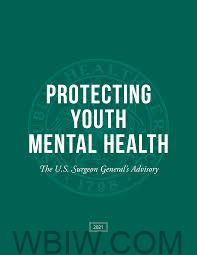
INDIANA – A Surgeon General’s Advisory is a public statement that calls the American people’s attention to an urgent public health issue and provides recommendations for how it should be addressed. Advisories are reserved for significant public health challenges that need the nation’s immediate awareness and action.
WBIW will look at this advisory that offers recommendations for supporting the mental health of children, adolescents, and young adults. While many of these recommendations apply to individuals, the reality is that people have widely varying degrees of control over their circumstances. As a result, not all recommendations will be
feasible for everyone. That’s why systemic change is essential.
The Advisory includes essential recommendations for the institutions that surround young people and shape their day-to-day lives – schools, community organizations, health care systems, technology companies, media, funders and foundations, employers, and government. They all have an important role to play in supporting the mental health of children and youth.

Mental health affects every aspect of our lives: how we feel about ourselves and the world; solve problems, cope with stress, and overcome challenges; build relationships and connect with others; and perform in school, at work, and throughout life. Mental health encompasses our emotional, psychological, and social wellbeing, and is an essential component of overall health, according to Vivek H. Murthy, M.D., M.B.A. Vice Admiral, U.S. Public Health Service Surgeon General of the United States.

As described in the 1999 Surgeon General’s Report on Mental Health is the “springboard of thinking and communication skills, learning, emotional growth, resilience, and self-esteem.”
Mental health challenges can be difficult to define, diagnose, and address, partly because it isn’t always clear when an issue is serious enough to warrant intervention. All of us, at all ages, occasionally experience fear, worry, sadness, or distress. In most cases, these symptoms are short-lived and don’t affect our ability to function. But, at other times, symptoms can cause serious difficulties with daily functioning and affect our relationships with others, as in the case of conditions such as anxiety disorders, major depressive disorder, schizophrenia, bipolar disorder, and eating disorders, among others, according to the report.
Mental health conditions can be shaped by biological factors, including genes and brain chemistry, and environmental factors, including life experiences. Some mental health disorders seem to cluster in families, but they are often shaped by multiple genes, and whether an individual develops symptoms can be further modified by their experiences and surrounding environment.

Environmental factors can range from exposure to alcohol or drugs during pregnancy, to birth complications, to discrimination and racism, to adverse childhood experiences (ACEs) such as abuse, neglect, exposure to community violence, and living in under-resourced or racially segregated neighborhoods.
ACEs can undermine a child’s sense of safety, stability, bonding, and wellbeing, Moreover, ACEs may lead to the development of toxic stress. Toxic stress can cause long-lasting changes, including disrupting brain development and increasing the risk for mental health conditions and other health problems such as obesity, heart disease, and diabetes, both during and beyond childhood as well as for future generations.
Biological and environmental factors can also be interrelated, making it difficult to isolate unique “causes” of mental health challenges. For example, if a child is genetically predisposed to depression, they might be more affected by experiences such as bullying than other children
Even before the COVID-19 pandemic, mental health challenges were the leading cause of disability and poor life outcomes in young people, with up to 1 in 5 children ages 3 to 17 in the US with a reported mental, emotional, developmental, or behavioral disorder.
In 2016, of the 7.7 million children with treatable mental health disorders, about half did not receive adequate treatment.
Unfortunately, in recent years, national surveys of youth have shown major increases in certain mental health symptoms, including depressive symptoms and suicidal ideation. From 2009 to 2019, the proportion of high school students reporting persistent feelings of sadness or hopelessness increased by 40%; the share seriously considering attempting suicide increased by 36%, and the share creating a suicide plan increased by 44%.

Between 2011 and 2015, youth psychiatric visits to emergency departments for depression, anxiety, and behavioral challenges increased by 28%.
Between 2007 and 2018, suicide rates among youth ages 10-24 in the US increased by 57%. Early estimates from the National Center for Health Statistics suggest there were tragically more than 6,600 deaths by suicide among the 10-24 age group in 2020.
Scientists have proposed various hypotheses to explain these trends. While some believe that the trends in reporting of mental health challenges are partly due to young people becoming more willing to openly discuss mental health concerns, other researchers point to the growing use of digital media, increasing academic pressure, limited access to mental health care, health risk behaviors such as alcohol and drug use, and broader stressors such as the 2008 financial crisis, rising income inequality, racism, gun violence, and climate change.
It’s also important to acknowledge that the prevalence of mental health challenges varies across subpopulations. For instance, girls are much more likely to be diagnosed with anxiety, depression, or an eating disorder, while boys are more likely to die by suicide or be diagnosed with a behavior disorder, such as attention deficit hyperactivity disorder (ADHD).
In recent years, suicide rates among Black children (below age 13) have been increasing rapidly, with Black children nearly twice as likely to die by suicide than White children.
Moreover, socioeconomically disadvantaged children and adolescents – for instance, those growing up in poverty – are two to three times more likely to develop mental health conditions than peers with higher socioeconomic status.
The next story will look at the COVID-19 pandemic’s impact on the mental health of children and youth.



